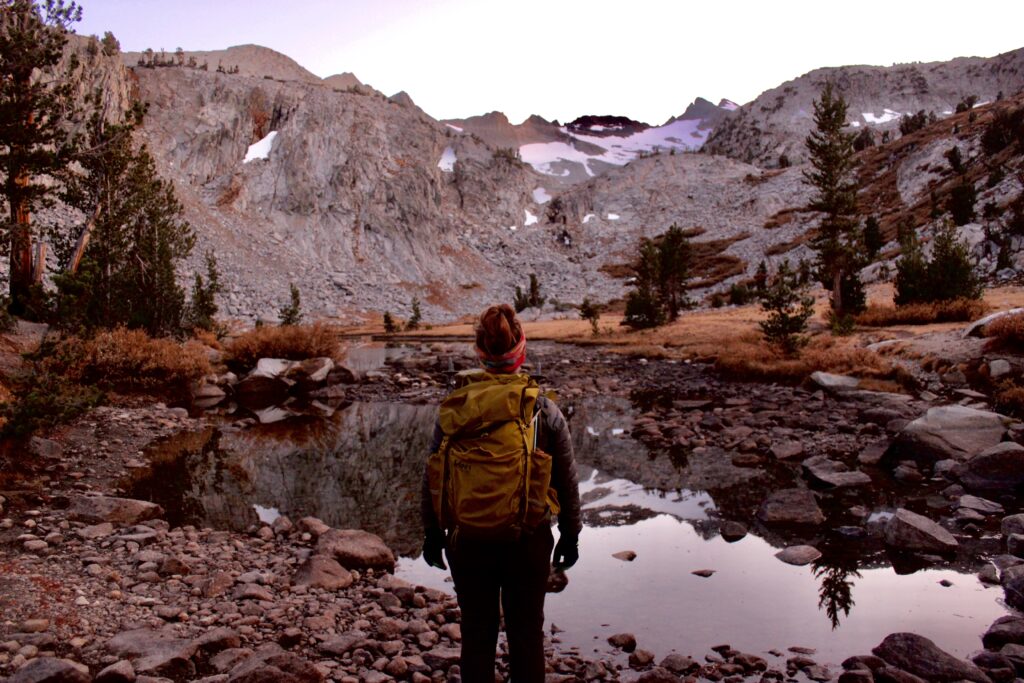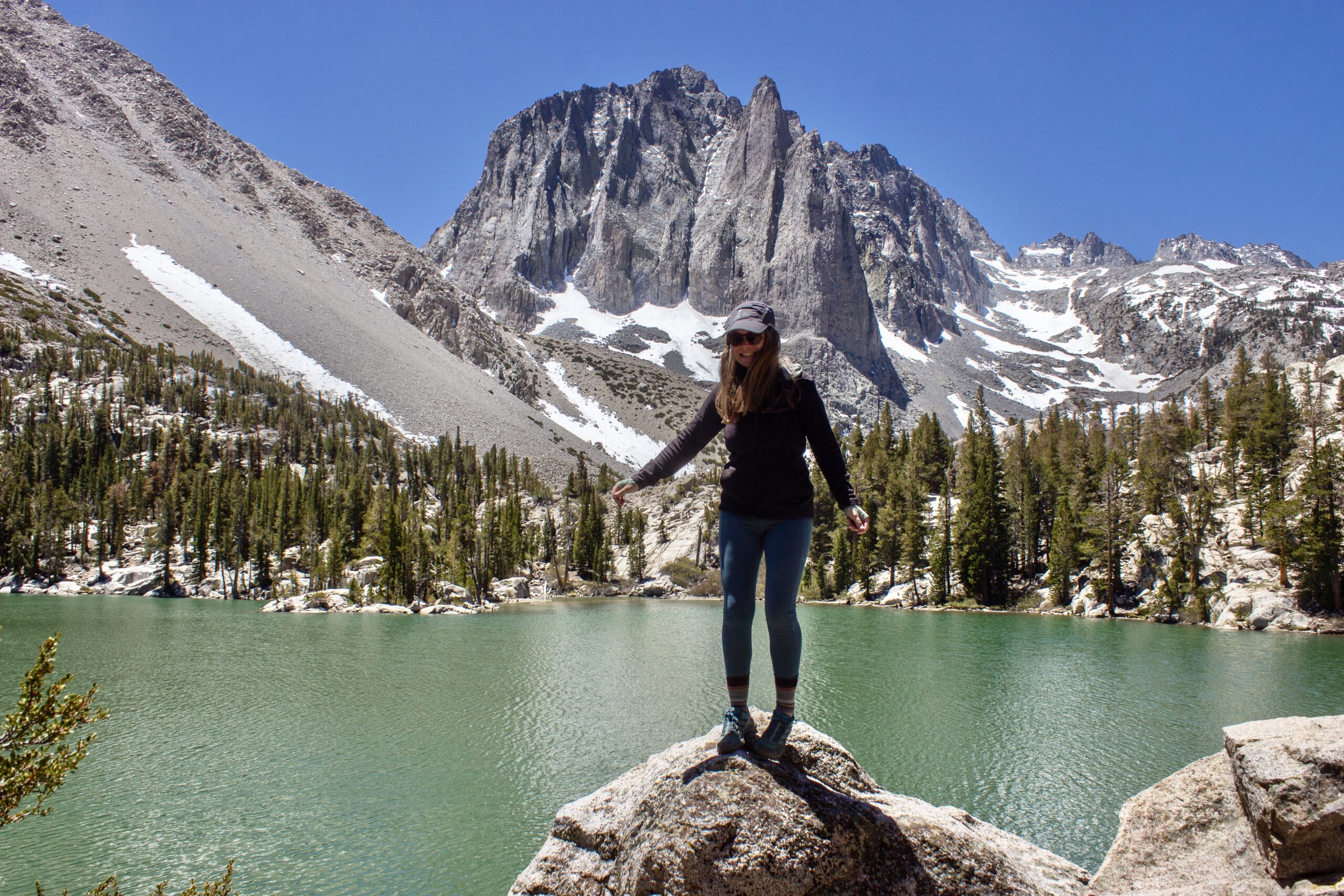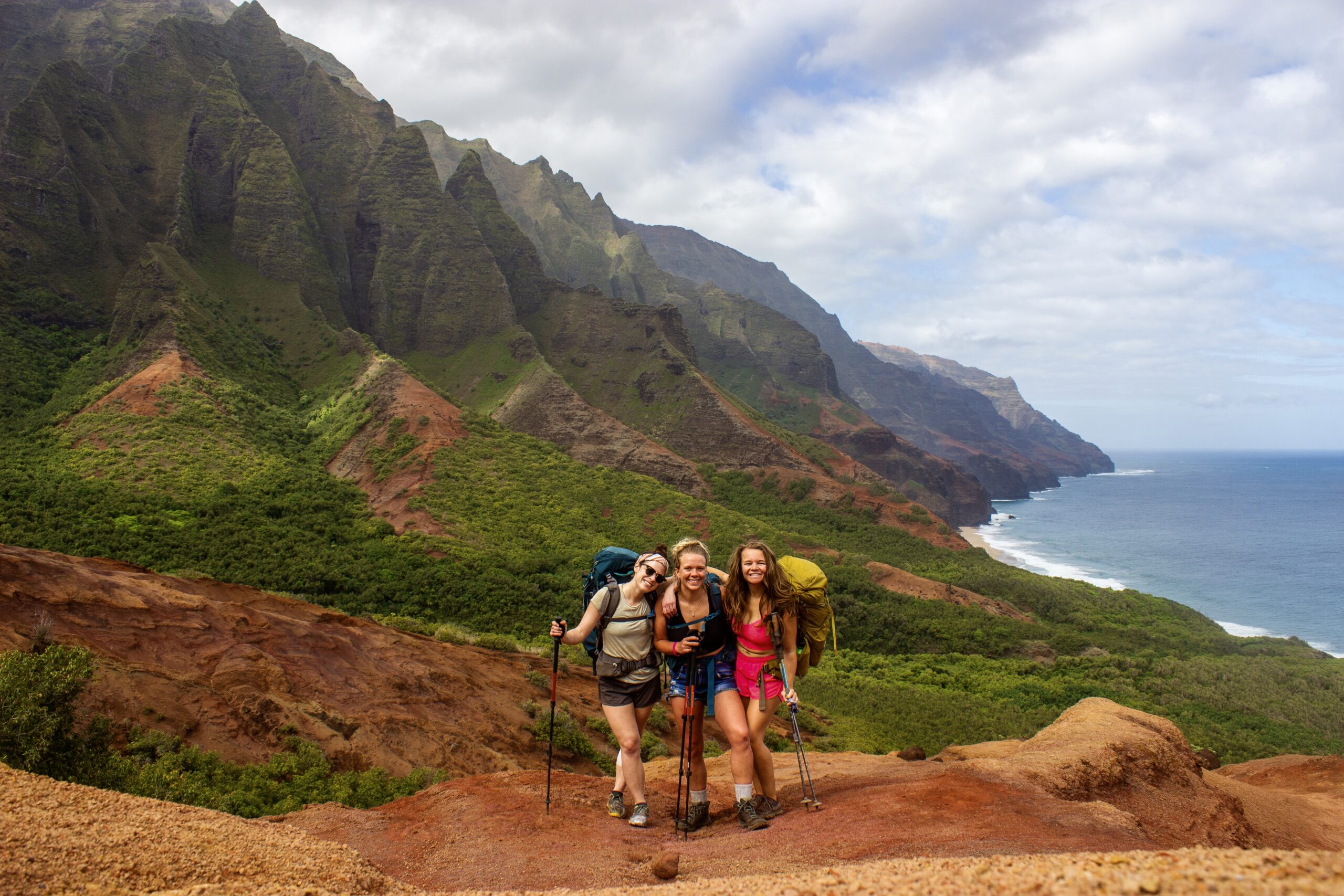Backpacking for Beginners; Planning Your First Backpacking Trip

Backpacking is one of the most incredible ways to explore pristine backcountry wilderness that is only accessible by foot however, learning how to plan your first backpacking trip requires some prep. I’ve put together this Backpacking for Beginners guide to help you plan, prepare, and hit the trail.
With over 10 years of backpacking experience and 3 years of working as a professional backpacking guide, this guide covers everything you need to know to have a smooth and fun first backpacking trip!
Choosing a destination to go backpacking

First and foremost, you must choose where you want to go on your first backpacking trip. Start small and go somewhere familiar. Familiarity with the environment or area will help your trip flow smoothly.
One of the biggest questions I get from beginner backpackers looking to plan their trip is how do I feel safe? These are a few tips to help with that.
Choose a destination close to home or where you day hike

Plan your first backpacking trip in an environment where you are already comfortable. Within a few hours of your home is a great place to start.
Likely you’ll already know the local wildlife, weather conditions, and the terrain of the trail.
My first backpacking trips were in areas I frequently day-hiked. I already knew the environment, terrain, and what to expect of the area so I was a lot more comfortable pitching my tent than in the remote, foreign location for the night.
Choose an established backcountry destination

Choosing a frequented trail is a great place to start. While it’s incredible to spend a night in the backcountry where no one else is around, sometimes it’s comforting knowing that other people are nearby in the very rare case that something happens.
It’s also nice to meet other people on the trail. I’ve heard so many crazy and funny stories from other hikers. Sometimes the company is nice and makes the experience.
Pick an easy to moderate route – minimal elevation gain and mileage

Start small. Don’t plan to hike 20 miles a day with over 3000 feet of elevation gain. Choose something well within your day hiking ability then scale it back a bit.
Carrying a backpack is TOUGH. It’s heavy, there’s lots of pressure on your shoulders and feet, and you tire a lot quicker.
Choose a trail that’s only a few miles each day, with minimal elevation gain, before jumping into a big trip.
Consider the average weather at that time of year

Plan your trip when the weather is likely going to cooperate. I would avoid hiking in the desert in the middle of summer and I’d wait until after the snow melts to hike in the high mountains.
Take wind into consideration too. It’s no fun pitching a tent in 25 mph wind, and good luck getting any sleep.
Check water accessibility

In many regions of the US, water is more accessible in the spring and early summer and becomes more limited as the season continues and snow melts away.
Consider this when planning your trip. If you plan to hike in the desert in the fall when temperatures are cool, you’ll probably have to pack in a lot of water.
Wherever you go backpacking, you must plan to camp near a source of drinkable water.
Planning your backpacking trip

After you’ve chosen a destination you need to plan the logistics of your trip. Preparation is essential any time you recreate outdoors. Of any problems that happen in the wilderness, most can be prevented if you properly plan. Here are some tips to help with that.
Map out your route
There are many options for maps nowadays but I always recommend both a map on your phone and carrying a paper map (and knowing how to read it). You never know when your phone might die.
In addition to a paper map, there are so many online resources that map out trail routes.
- AllTrails is a very popular app where you can see previously hiked routes and download the topo for them. These previously mapped routes are also a great option for your first backpacking trip since they are likely in well-established areas.
- GAIA and CalTopo are two other topographic mapping apps that offer extensive trail mapping opportunities. These apps are more advanced and while they are very useful, you’ll have to personally create and download the map.
Check to see if you need permits
Many national parks, national forests, and wilderness areas require permits for any overnight backcountry backpacking trips.
Research the permit requirements ahead of time. Some locations require permits reserved months in advance while other areas have walk-up permits obtainable at a ranger station.
Some places also require hikers to carry a fire permit. This is required for anyone burning any type of fire in the backcountry, including cooking on a small camp stove. Often you can obtain this permit online and carry it on your phone.
Read the rules and regulations of the area you choose to go backpacking

Every destination you plan a backpacking trip to has specific rules and regulations in place for the protection of hikers, wildlife, and the environment you’re recreating.
Some common restrictions include fire bans, how close you can camp to water and the trail, and what precautions to take for food safety.
It’s important to follow the implemented rules on your backpacking trip for your safety and to help it run smoothly.
It’s also important to read up on regional conditions and wildlife. Inform yourself ahead of time about what wildlife is common in the area and how to protect yourself from an interaction.
Also, research the area’s water supplies, the possibilities of storms, and other environmental factors that can influence your trip. Visitor centers and ranger stations are also great resources for this information.
Tell someone where you’re going backpacking

You should always let someone know where and when you’re heading into the backcountry whether you’re going on a backpacking trip or a familiar day hike.
Let them know the area you’ll travel in, the route you plan to take, when you plan to return if you will have cell service there, and when you’ll notify them that you’re safe and done with the trip.
If you won’t have service the night you complete the trip, tell them the time you’ll first have service to contact them. I also give friends a backup time in case I’m running late for any reason.
Purchase a satellite communicator
Carrying a satellite communication device is very beneficial so you can update friends or family members during your trip, while out of cell service. I take my Garmin InReach Mini on every backpacking trip.
The Garmin InReach Mini is a 2-way satellite communication device that allows texting and responses to and from an email or phone number. Each text can tag your GPS coordinates and share them with your selected contacts.
In the event of an emergency, there is an SOS button to get help from search and rescue. A device with 2-way communication is great because you can communicate back and forth with dispatch about the intensity of the situation so they can determine the most efficient rescue.
Get the proper backpacking gear

Backpacking requires a lot of gear and it must fit you comfortably. Here’s an idea of what you need for backpacking.
- 55 – 65 L Backpack
- 3-Season Tent
- Sleeping Bag (15 – 30 degrees)
- Sleeping Pad
- Cooking Stove
- Fuel
- Lightweight Pot/Pan & Spork Utensil
- Food
- Pocket Knife
- Headlamp
- Water Filter
- Hiking Boots or Shoes
- Layers of Clothing
- First Aid Kit
- Hiking Poles
- Map
- Water Shoes or Sandals
- Sun Hat & Warm Hat
- Sunglasses
- Sunblock
- Permits
Physically prepare

Backpacking is significantly tougher than hiking because you’re carrying a heavy backpack weighing between 25 – 35 pounds. Physically preparing your body for your first backpacking trip in advance will make your trip more comfortable and enjoyable.
Start by carrying a heavy backpack on day hikes. This will help you adjust to the extra weight. Lengthen the mileage of your day hikes and increase your elevation gain as you become stronger. If you don’t have anyone to day hike with, it’s a great time to start solo hiking!
Cardio activities that raise your heart rate are also beneficial. If you can’t go hiking up steep mountains before your trip, running or cycling are some alternatives to get in shape.
Food Prep

Food prep is pretty time-consuming and can significantly affect the weight of your backpack.
You will likely consume far more calories while backpacking than when you’re hanging out at home, and your body needs those extra calories.
Surprising to most, there are plenty of options to cook healthy, tasty meals in the backcountry.
When packing it’s important to pack caloric and nutrient-rich foods, preferably those that weigh the least. A few popular options for each meal include:
Breakfast: oatmeal with peanut butter or almond slivers, pancakes that only require water added, breakfast bars, hot cereal with dried fruit, granola with powdered milk
Lunch: tortillas with peanut butter and honey, tortillas with hummus and veggie slices, bagels or bread with packets of salmon, chicken, or tuna
Dinner: dehydrated meals such as pasta, quinoa, polenta, or rice with dehydrated veggies. Add a tortilla for burritos. Add protein with veggie sausage or packets of salmon, chicken, or tuna. Prepackaged dehydrated meals are also a great option and are packed with calories and nutrients
Snacks: nuts, trail mix, granola and nut bars, cheese and crackers, dried meats, dehydrated hummus, dehydrated peanut butter
Plan and pack your food ahead of time because it will take longer than expected.
Hitting the Trail

So you’ve chosen your destination, bought your food and gear, mapped your route, and notified your family. Now you’re parked at the trailhead and you have a few more things to do.
Pack your pack
Properly packing your backpack is key for comfort on the trail. To start you want to minimize the amount of weight you’re carrying and only take the essentials.
When packing your backpack it’s important to properly distribute weight.
Bottom of your backpack: Store midweight items here. Items that you don’t need until camp like sleep clothing, your sleeping bag, and a sleeping pad should go at the bottom.
Center of your backpack: Your heaviest items should go in the center of your backpack against your back. Like cooking gear, a tent, or a bear canister.
The upper part of your backpack: Lighter items like spare clothing can be used to fill the upper space of your pack and fill the gaps throughout. Keep rain layers at the top of your backpack here.
The brain of the backpack: The brain is the upper zipper section of your pack that allows easy access while on the trail. Store frequently used items like sunblock, a hat, snacks, and bug spray here.
Sides of the backpack: Like the brain, keep frequently used items on the sides of the backpack because they are easily accessible.
Hip belt pockets: The pockets on the hip belt are great for storing frequently used items like snacks, chapstick, a knife, and a phone.
Over time you’ll figure out the best packing set up for yourself that will maximize comfort and efficiency.
Avoid dangling items off of your backpack as they can easily snag branches or fall off and you’ll never see them again.
Follow proper food storage protocol

Properly storing your food is very important when backpacking. Who wants to return to camp and see a squirrel in their dinner? Or worse, a bear shaking your tent in the middle of the night.
Most places have regulations for proper food storage when backpacking. This is especially important when backpacking in bear country. In many areas bear canisters or some type of bear-proof storage is required.
In other places, regulations might allow bear hangs from trees but it’s important to look up this information before you head out into the backcountry.
Follow Leave No Trace Ethics

The 7 principles of Leave No Trace were created for the protection of the wilderness, wildlife, and those visiting it. I could easily go into great depth about these principles however, here is the main idea of them. And when you have time, check out more about the 7 Principles of Leave No Trace!
Plan Ahead and Prepare
Always tell someone where you’re going, research the area ahead of time, obtain necessary permits, check the weather, plan a route, and get a map.
Travel and Camp on Durable Surfaces
Avoid walking and camping on vegetation, stick to the trails, and camp in pre-established campsites or where there is no vegetation. Camp at least 100 feet from water sources and trails.
Properly Dispose of Waste
Pack out all waste: banana peels, wrappers, toilet paper, everything. Properly bury human waste by digging a cathole 6 – 8 inches deep at least 200 feet from any water source and at least 100 feet from any trail. Cover the hole back over when finished.
Leave What You Find
Don’t take anything from the environment; pinecones, rocks, flowers, arrowheads. Leave everything there for others to enjoy. Don’t pull or trample through wildflowers and meadows; these are fragile environments.
Minimize Campfire Impacts
Check fire restrictions and if fires are permitted fully douse them with water when finished. Use pre-established campfire rings when available. If you create your ring, disperse the rocks afterward and after the fire is completely drenched, make the area look like it was not used.
Respect Wildlife

Give wildlife their space for both your and the animal’s safety. Don’t make loud noises around wildlife unless you’re scaring it away for your safety.
Be Considerate of Others
Respect others on the trail. Don’t play music while backpacking. Let uphill hikers have the right of way when passing. Keep noise to a minimum. Greet others on trail, you never know, they might provide you with helpful advice later.
Set a good pace
Take your time, especially on your first backpacking trip. Your backpacking pace will be a lot slower than your day hiking pace.
Avoid rushing yourself and panting painlessly out of breath. Instead, slow your pace; you have a ways to go and backpacking is a marathon, not a sprint.
Enjoy!

Backpacking is an incredible and rewarding experience and this backpacking for beginners guide is meant to help you achieve your goals. Take in as much as possible. Take breaks when needed, chat with other hikers about their experiences, and enjoy everything that is around you!



